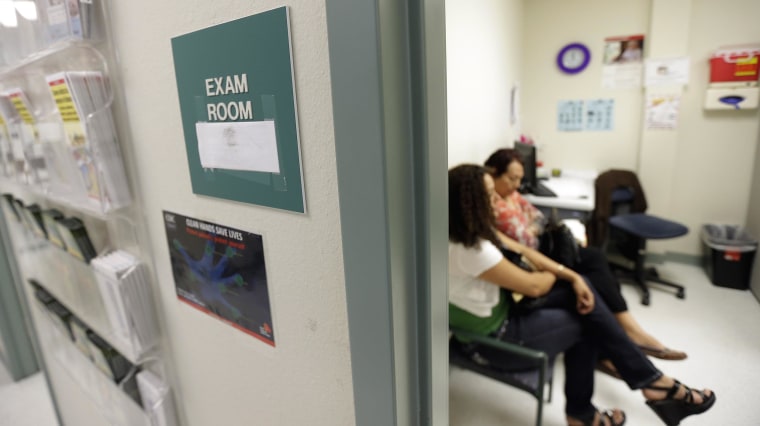It’s an annual ritual for millions of American women: Visiting the doctor and lying back for a routine pelvic exam, feet in stirrups. Now the nation’s largest largest medical specialty organization says that tradition needs to change.
A new guideline published Monday from the American College of Physicians says doctors should not do pelvic exams on non-pregnant adult women with no symptoms of disease. A review of the exams found they rarely catch disease but are costly, uncomfortable and even embarrassing.
“It is a fairly straightforward, simple guideline,” says Dr. Linda Humphrey, co-author of the guidelines published in Annals of Internal Medicine and a professor of medicine, public health and preventive medicine at Oregon Health & Science University in Portland. And it is based on a “very strong” review of nearly 70 years of medical studies, she says.
Sign up for top Health news direct to your inbox.
The guideline does not apply to Pap smear screening for cervical cancer, which should be done every three to five years, depending on a woman’s age. And it’s sure to be controversial — the American College of Obstetricians and Gynecologists remains in favor of an annual exam. American College of Physicians members are internists, specialists in the care of adults.
“There just wasn’t evidence that [routine pelvic examination] was beneficial,” says Humphrey. The review found that pelvic exams rarely detected ovarian cancer or bacterial infection and did not reduce mortality. Yet they add $2.6 billion in “unnecessary costs to the health care system,” according to the journal article.
The review also found potential harms, although the evidence was weak. These harms include embarrassment, fear, anxiety, pain and discomfort. Those were “magnified in women who had a history of sexual trauma, post-traumatic stress disorder or in overweight women,” says Humphrey.
Other potential harms include women avoiding health care visits because they dislike the exam and doctors finding abnormalities that don’t matter but that may lead to additional and invasive testing.
In a typical pelvic exam, the doctor examines external genitalia, inserts an instrument called a speculum into the vagina to examine the vagina and cervix, and then places a hand on the abdomen and the other inside the vagina to feel for abnormalities.
The new guideline recommends a pelvic exam only for women with symptoms such as vaginal discharge, abnormal bleeding, pain, urinary problems or sexual dysfunction. And it says cervical cancer screening should be limited to visual inspection of the cervix and swabbing the cervix for cancer and human papillomavirus; manual examination is not necessary.
Dr. Humphrey said nixing the pelvic exam doesn’t mean that women should not have an annual well visit.
"If it starts a conversation between a woman and her physician or provider, I think that is terrific and as it should be."
The American College of Obstetricians and Gynecologists agrees that there is no data showing that routine pelvic exams save lives or do a good job of detecting ovarian cancer or infection. But routine pelvic exams do have value, it says. Its guideline, published in 2012, continues to recommend exams and encourages women to discuss whether to have one with their health care provider. If a woman doesn’t want the exam, she should still have an annual check-up.
“It is the experience of the members of our practice committee and our executive board and those of us who created this guideline that, indeed, women coming to see us who are ‘asymptomatic’ often have issues that they want to discuss but don’t raise them with us initially,” says Dr. Barbara Levy, the group’s vice president for health policy. “The pelvic examination creates an opportunity for us to raise those issues with a patient if we see something on the exam.”
For example, a woman might be too embarrassed to talk about incontinence, but “the position of the urethra” — the tube from the bladder to the outside — “relative to other tissues can raise a red flag for a clinician that indicates, ‘I should ask her about whether she is leaking urine,’” says Levy.
Or an ob-gyn might observe during a pelvic examination that the muscles of the pelvic floor are extremely tight and don’t relax. “In my experience, that is frequently a woman who has an experience of sexual abuse of some kind, and she almost for sure is having sexual dysfunction but may be reluctant to discuss the issue unless I raise it with her,” says Levy.
Both Levy and Humphrey agree that women may come away from the different guidelines somewhat confused. “But if it starts a conversation between a woman and her physician or provider, I think that is terrific and as it should be,” says Levy.
Humphrey says confusion will change with time, as younger internists and ob-gyns more comfortable with evidence-based medicine dispense with the routine pelvic examination.
“Most family practitioners are already practicing this way, skipping the pelvic exam,” says Dr. Ranit Mishori, an associate professor of family medicine at Georgetown University. Now she would like to see gynecologists do the same.
But Levy doubts that most ob-gyns are going to drop the routine pelvic exam, nor should they, she says. “When women have these underlying issue that they’re hoping a physician will find and talk about, they’ll typically choose to see a gynecologist rather than an internist,” Levy says.

